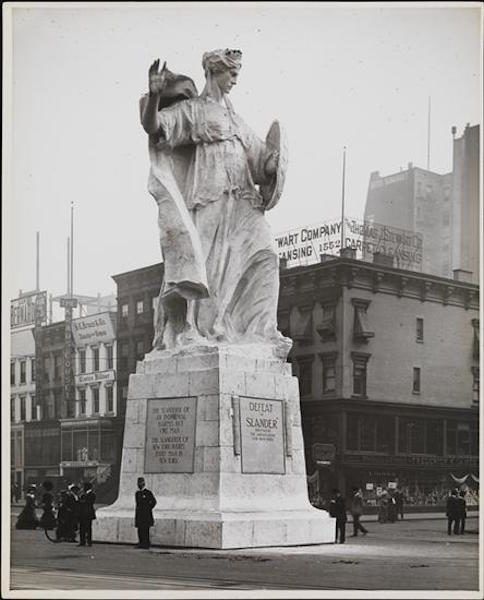Last-Minute NYC Holiday Gift Guide 🎁
We’ve created a holiday gift guide with presents for the intrepid New Yorker that should arrive just in time—



Image via The Museum of the City of New York
Nestled between 46th and 47th Streets in the northern triangle of Manhattan’s infamous Times Square stands a statue of Father Francis Patrick Duffy, the prominent military chaplain and priest who served the theater district after World War II. But long before Duffy became a ubiquitous feature alongside the hustle and bustle of tourists and TKTS, a statue of a woman stood in his very place. She was called Purity.
Her tenure in Times Square was short lived at just two months. But her history, though brief, is one rich in flavor from rise to fall. Standing at nearly 50-feet-tall, this statue featured a robed woman atop a pedestal, holding a shield in her left hand and looking down at passerby below with a stern facial expression.
Purity, sometimes referred to as Virtue or Defeat of Slander, was erected under a permit from the Bureau of Incumbrances in September of 1909, according to initial reporting from The New York Times. Leo Lentelli, an Italian immigrant and young sculptor, was the artist who gave her form.
William Harmon Black, who served as the president of New York City’s Board of Aldermen at the time, said that the statue would “represent a tall and snow-white woman of majestic figure and mien, somewhat angry and even disgusted at the slander and unjust fault-finding she has been subject to.”
Black was referring to the extensive amount of political corruption that plagued New York throughout the early 1900s. Tammany Hall, founded in opposition to the Federalist Party but often associated with turn of the century greed in New York City, was a possible target of this rhetoric. Black continued that Purity’s shield, which was inscribed with ‘Our City,’ would have “visible great dark blotches and spots to typify the mudslinging she had warded off.”
During her construction, New Yorkers had no idea what would eventually become of the high scaffolding and secrecy. The New York Times mentioned confusion and intrigue among people working in close quarters to Times Square. A newsboy assumed another Statue of Liberty was in the works.
This did not end up as the case. Purity served a purpose, perhaps an all-too-fleeting one.
The eight-ton statue’s life ultimately came to an end in November of 1909. The reason for her destruction was claimed to be caused by heavy rains, which led Lentelli’s plaster sculpture to melt. In the days following, New Yorkers were not so kind to the 50-foot structure as she came down. The article “Miss Purity Displaced: Back to the Dust Pile for Her” explained that “her last moments were typical of her life.” After all, she was constructed during a time when there was a misbehaving government and general distrust among citizens.
A workman crawled up Purity and hit her head with a hammer in a heavy blow. Others climbed onto her shoulders and began to go to town on her left arm. The words that were once inscribed at her base, originally intended to symbolically fend off mudslingers and corruption, were replaced with advertisements for nearby theaters. As Purity’s body parts fell to the street below, each became powder and dust. The statue that “had once looked so formidable” became “a very small pile of white bits.”
Today, the history of Purity has largely been written over. But perhaps when you walk past Duffy now, you will reflect on the statue that predated him.
Want to learn more about the history of Times Square? Join us for an upcoming Remnants of Gritty Old Times Square Walking Tour to uncover the area’s seedy past.
Next, check out The Top 10 Secrets of Tammany Hall and a Giant, Reflective Lens in Times Square for Valentine’s Day.
Subscribe to our newsletter